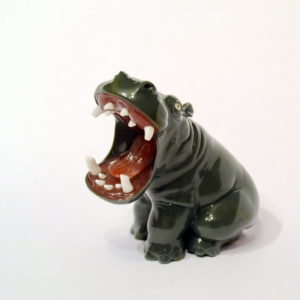Stone carving sculpture
According to Tillander-Godenhielm, Kremlev had twenty carvers at his workshop, an indica- tion of the level of demand for hardstone objects during Henrik WIgstrom’s period as head workmaster (1903-17).4 The stonecarving workshops would prepare the pieces to the specification of Faberge’s workmaster and the carved stone would then be sent to Faberge’s workshops for pol- ishing and for any metal components to be fitted, for example the gold legs of certain birds
Faberge’s sculptors carefully selected the correct stone to emulate the colouring of a particular animal or to give an impression of its texture in real life. Some of the best examples of this technique in the Royal Collection are the snail (cat. 55) and the seal (cat. 86). There are, however, occasional humorous departures from realism, such as the red elephant (cat. 94) and the green bulldogs (cat. 38 and 39). For the most part, the carefully observed poses and intri- cately carved details of Faberge’s animals – with every feather and hair described – set them apart from those produced by his contemporaries and competitors ().
There are in the region of three hundred animals by Faberge in the Royal Collection and this constitutes the largest collection of his animals anywhere in the world.
It seems that the British royal family’s love of animals was greater even than that of the Russian imperial family. In an inventory of the possessions of Marie Feodorovna and Alexander III, compiled after the Revolution of 1917 by Major General ^erekhovich, chief director of the Anichkov Palace, approximately a hundred stone animals were listed.5 It should be borne in mind that Marie Feodorovna, like her English relatives, bought many of Faberge’s animals as gifts for her family and friends.
An exceptional variety of animals and birds is included in the Royal Collection, which was formed during the pro- duction period of two of Faberge’s head workmasters, Michael Perchin from 1886 to 1903 and Henrik Wigstrom from 1903 to 1917. The majority of the collection, as already mentioned, was formed by King Edward VII and Queen Alexandra in connection with the King’s commission of 1907 (see pp. 21-4). Other animals were acquired both earlier and for many years afterwards.
The earliest royal purchase of animals from Faberge’s London branch was made by Queen Alexandra on 29 Octo- ber 1906, when she bought a rabbit and an owl, both in agate.
On the same occasion she purchased the frog cigar lighter (cat. 82). Her famous collection of animals may have already been started before that date, through gifts from her family and friends. It was well known that of all Faberge’s products she preferred animals and flowers.
Once the Sandringham models began to be carved in St Petersburg and dispatched back to the London branch, the collection grew rapidly. Many additional animals were purchased by King George V and by his sister Princess Victoria, such as the owl on a perch (cat. 58) and the kan- garoo (cat. 85). Even after the closure of the London branch in 1917 King George V and Queen Mary continued to acquire animals from other sources, notably from the dealers Wart- ski (cat. 68) and from Prince Vladimir Galitzine, from whom Queen Mary acquired two parrots, a duck, a cockerel and an agate bird between 1928 and 1930.6 In more recent years, Queen Elizabeth acquired two elephants (cat. Ill and 113) and a sparrow () amongst other animals.
Stone carving sculpture
King Edward VIFs initial idea for the 1907 commission was for the favourite royal dogs and race- horses to be immortalised by Faberge. Caesar, the King’s beloved Norfolk terrier, would certainly have been one of the most important subjects to be modelled. Caesar was bred by the Duchess of Newcastle c.1895 and of the many dogs that King Edward owned – basset hounds, Clumber spaniels, chow-chows and French bulldogs – he was the King’s favourite.
The King clearly doted on Caesar, who accompanied his master almost everywhere, even to Biar- ritz and Marienbad. On one occasion Caesar was taken ill abroad and the King even contemplated summoning his vet from London to treat him. On 8 December 1907 the King unveiled the animals mod- elled in wax to Queen Alexandra and the assembled guests at Sandringham, and Caesar accompanied the party to the Dairy, where his own likeness, wearing a collar inscribed I belong to the King, was among the waxes.

Faberge and his workmasters had the ability to imbue their models with personality and this expressive portrait certainly matches contemporary descriptions of the way Caesar would wag his tail and ‘smile cheerfully’ up into his master’s eyes when King Edward scolded him for misbehaving. Such was their mutual devotion that Caesar wandered the corridors of Buckingham Palace in search of his mas- ter in the days following the King’s death on 6 May 1910. Caesar’s final duty was to walk behind the King’s coffin, led by a Highlander, in the funeral procession from Westminster to Paddington on 20 May 1910. A portrait by Maud Earl painted at this time and entitled Silent Sorrow was reproduced in the Illus- trated London News of 21 May 1910. Caesar died in 1914 and is buried in the grounds of Marlborough House in London. A carving of him in marble sits at the feet of the King on his tomb in St George’s Chapel, Windsor.